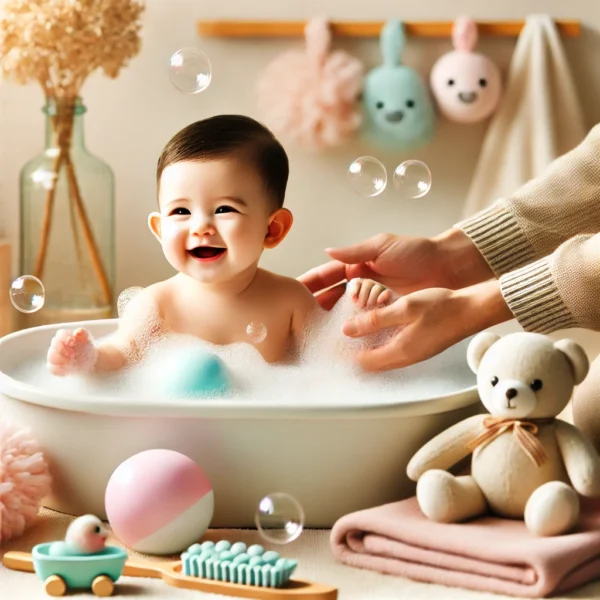Bathing and Hygiene for Babies: A Comprehensive Guide for New Parents
Bringing home a newborn is one of life’s greatest joys, but it comes with the responsibility of ensuring your little one is healthy and happy. Bathing and hygiene are essential parts of this care, helping keep your baby comfortable and free from infections. Here’s everything you need to know about baby hygiene, along with some helpful tips to make bath time a pleasant experience for both of you.

How Often Should You Bathe Your Baby?
For newborns, it is recommended to bathe them two to three times a week. Their skin is sensitive, and overbathing can strip away natural oils, causing dryness. Between baths, you can use a soft washcloth to gently clean their face, neck, and diaper area.
Once your baby starts crawling and exploring more, you can increase the frequency as needed.
Baby Bath Essentials
Before you begin, it’s essential to have all the necessary items within arm’s reach to ensure a smooth and safe experience. Here's what you'll need:
Baby bathtub (with a non-slip surface)
Mild, fragrance-free baby soap
Soft washcloths
Rinsing cup or a small container
Hooded towel to keep your baby warm after the bath
Clean diaper and fresh clothes
Baby lotion (optional for dry skin)
Step-by-Step Guide to Bathing Your Baby:
1. Choose the Right Time
Select a time when your baby is calm and not too hungry or tired. Many parents choose to incorporate bath time into their evening routine, as it can be soothing before bed.
2. Fill the Tub with Lukewarm Water
Use about 2-3 inches of lukewarm water (around 100°F or 37.8°C). Always test the water with your elbow or a thermometer to make sure it’s not too hot or cold.
3. Support Your Baby
Gently place your baby in the tub, supporting their head and neck with one hand. Keep most of their body above water to prevent them from getting too cold. Use the washcloth to gently wash their face and body.
4. Wash from Top to Bottom
Start by cleaning your baby’s face with water only. Use a mild baby soap to wash their body, paying special attention to folds and creases under the arms, behind the ears, and around the neck. Be gentle, especially when washing the soft spot (fontanel) on their head.
5. Rinse Thoroughly
Using a rinsing cup, pour clean, warm water over your baby’s body to remove soap. Make sure no soap is left on their skin, as it can cause irritation.
6. Dry and Moisturize
After the bath, immediately wrap your baby in a hooded towel to keep them warm. Pat them dry, paying attention to the creases in their skin. If your baby’s skin seems dry, you can apply a gentle baby lotion.
Nail and Hair Care for Babies:
Hair Care:
Newborns don’t need frequent hair washing. You can wash their scalp with water during bath time, using a small amount of baby shampoo once or twice a week. If your baby has cradle cap (dry, flaky skin on the scalp), gently brushing their hair with a soft brush can help remove the flakes.
Nail Care:
Baby nails grow quickly and can be quite sharp, leading to accidental scratches. Use baby nail clippers or a baby nail file to trim them safely. It’s easiest to cut them when your baby is asleep or calm.
Diapering and Hygiene:
Diapering is an essential part of baby care that ensures a baby remains clean, dry, and comfortable. Proper diapering helps prevent diaper rash, irritation, and infections, contributing to the baby’s overall health and happiness. Here’s a comprehensive guide on diapering for baby care:
1. Types of Diapers
- Disposable Diapers: Convenient, absorbent, and easy to use, these are the most common choice. They come in various sizes based on the baby's weight and absorbency needs.
- Cloth Diapers: Eco-friendly and reusable, cloth diapers are made from natural fibers such as cotton or bamboo. They require regular washing but are cost-effective over time.
- Hybrid Diapers: These combine elements of both disposable and cloth diapers, often featuring a washable cover with a disposable insert.
2. When to Change Diapers
- Newborns typically need diaper changes every 2-3 hours, as they urinate frequently.
- Older babies may need a diaper change every 3-4 hours.
- Always change the diaper immediately after bowel movements to prevent diaper rash and infections.
3. How to Diaper a Baby
- Prepare: Have all necessary supplies within reach, including a clean diaper, wipes, diaper rash cream, and a changing pad.
- Cleaning: Gently wipe the baby’s bottom with baby wipes or a soft cloth. Clean from front to back, especially for girls, to avoid spreading bacteria.
- Drying: Allow the area to air dry or gently pat it dry with a soft cloth. This prevents moisture, which can lead to rashes.
- Applying Cream: If necessary, apply a thin layer of diaper cream or ointment to protect the skin and prevent rashes.
- Fasten the Diaper: Slide a fresh diaper under the baby, making sure the adhesive tabs are at the back. Secure the diaper snugly but not too tightly, ensuring there's enough room to fit two fingers between the diaper and the baby’s waist.
4. Diaper Rash Prevention
- Frequent Diaper Changes: Keep the baby’s skin dry by changing diapers regularly.
- Allow Diaper-Free Time: Letting the baby go without a diaper for some time each day helps air out the skin.
- Use Barrier Creams: Creams containing zinc oxide or petroleum jelly form a barrier that protects the skin from moisture and irritation.
- Choose Diapers Wisely: Opt for diapers that fit well and are made from breathable materials to avoid trapping heat and moisture.
5. Proper Diaper Disposal (for disposables)
- Roll up the used diaper and secure it with the adhesive tabs.
- Place it in a diaper pail or a sealed plastic bag to contain odor and bacteria before disposal in the trash.
6. Washing Cloth Diapers
- Rinse soiled cloth diapers to remove solid waste.
- Store in a diaper pail with a liner until washing.
- Wash with mild detergent and warm water, and consider adding an extra rinse cycle to ensure all detergent is removed. Sun drying can help naturally sanitize and remove stains.
7. Choosing the Right Diaper Size
- Choose a diaper size based on the baby’s weight, as indicated by the diaper brand.
- If the diaper leaves marks on the baby’s skin or leaks frequently, it may be time to switch to a larger size.
8. Travel Diapering Essentials
- Always pack a diaper bag with enough diapers, wipes, a portable changing mat, diaper cream, and extra clothes.
- Consider using travel-sized diaper disposal bags to manage used diapers on the go.
9. Nighttime Diapering
- For nighttime, opt for high-absorbency diapers to reduce the frequency of changes and help the baby sleep through the night.
- Some parents use diaper boosters or special overnight diapers for extra protection.
Tips for Keeping Baby’s Skin Healthy
Caring for a baby’s skin requires special attention because it is delicate, sensitive, and prone to irritation. Developing a gentle skincare routine helps protect their skin and maintain its health. Here are some tips and recommendations for keeping a baby’s skin healthy:
1. Gentle Cleansing
Babies do not need to be bathed every day; 2-3 times a week is sufficient to keep them clean while preserving the natural oils in their skin. Use lukewarm water and a mild, fragrance-free baby soap to cleanse their skin. Avoid harsh soaps, which can strip away natural moisture, leading to dryness.
2. Moisturizing
After bathing, it’s important to apply a gentle moisturizer to lock in hydration. Choose baby lotions or creams that are free from fragrances, dyes, and other harsh chemicals. For very dry or sensitive skin, use a thicker, hypoallergenic moisturizer or an ointment like petroleum jelly.
3. Diaper Area Care
Keeping the diaper area clean and dry is essential to prevent diaper rash. Change diapers frequently, especially after the baby wets or soils them. Clean the area with gentle wipes or warm water, and allow it to air-dry before putting on a fresh diaper. Using a barrier cream with zinc oxide can protect the skin from irritation caused by moisture.
4. Sun Protection
Babies have sensitive skin that is more susceptible to sunburn. If you’re outdoors, keep your baby in the shade and use a wide-brimmed hat to protect their face. For babies older than 6 months, you can apply a baby-safe, broad-spectrum sunscreen with SPF 30 or higher. Avoid direct sun exposure for infants under 6 months.
5. Clothing Choices
Dress your baby in soft, breathable fabrics like cotton. Avoid materials that may cause irritation, such as wool or synthetic fabrics. When washing baby clothes, use a mild, fragrance-free detergent designed for sensitive skin to avoid allergens and irritants.
6. Hydration
Make sure your baby stays hydrated, especially in warm weather. Breastfeeding or formula feeding should provide adequate hydration for young infants, while older babies can also have small amounts of water. Hydration helps maintain skin moisture from the inside out.
7. Watch for Skin Conditions
Babies can experience various skin conditions like eczema, baby acne, and cradle cap. Eczema, in particular, requires extra care. Use fragrance-free products and consult a pediatrician if you notice persistent redness, itching, or dry patches. For cradle cap, gently massage baby oil into the scalp before using a soft brush to loosen flakes.
8. Avoid Overheating
Overheating can irritate the baby’s skin, causing heat rash or discomfort. Keep the baby’s environment cool and ensure they aren’t overdressed. Lightweight, breathable clothing and keeping the room at a comfortable temperature can help prevent skin issues caused by excess sweating.
Conclusion
Maintaining healthy baby skin involves gentle care, hydration, and protection from irritants. Opt for baby-specific skincare products and avoid those containing harsh chemicals. Regularly moisturizing, cleansing, and protecting their delicate skin from the sun will ensure it stays soft and healthy. Always consult a pediatrician if any skin issues arise that do not improve with basic care.
4o
Caring for a baby’s skin requires special attention because it is delicate, sensitive, and prone to irritation. Developing a gentle skincare routine helps protect their skin and maintain its health. Here are some tips and recommendations for keeping a baby’s skin healthy:
1. Gentle Cleansing
Babies do not need to be bathed every day; 2-3 times a week is sufficient to keep them clean while preserving the natural oils in their skin. Use lukewarm water and a mild, fragrance-free baby soap to cleanse their skin. Avoid harsh soaps, which can strip away natural moisture, leading to dryness.
2. Moisturizing
After bathing, it’s important to apply a gentle moisturizer to lock in hydration. Choose baby lotions or creams that are free from fragrances, dyes, and other harsh chemicals. For very dry or sensitive skin, use a thicker, hypoallergenic moisturizer or an ointment like petroleum jelly.
3. Diaper Area Care
Keeping the diaper area clean and dry is essential to prevent diaper rash. Change diapers frequently, especially after the baby wets or soils them. Clean the area with gentle wipes or warm water, and allow it to air-dry before putting on a fresh diaper. Using a barrier cream with zinc oxide can protect the skin from irritation caused by moisture.
4. Sun Protection
Babies have sensitive skin that is more susceptible to sunburn. If you’re outdoors, keep your baby in the shade and use a wide-brimmed hat to protect their face. For babies older than 6 months, you can apply a baby-safe, broad-spectrum sunscreen with SPF 30 or higher. Avoid direct sun exposure for infants under 6 months.
5. Clothing Choices
Dress your baby in soft, breathable fabrics like cotton. Avoid materials that may cause irritation, such as wool or synthetic fabrics. When washing baby clothes, use a mild, fragrance-free detergent designed for sensitive skin to avoid allergens and irritants.
6. Hydration
Make sure your baby stays hydrated, especially in warm weather. Breastfeeding or formula feeding should provide adequate hydration for young infants, while older babies can also have small amounts of water. Hydration helps maintain skin moisture from the inside out.
7. Watch for Skin Conditions
Babies can experience various skin conditions like eczema, baby acne, and cradle cap. Eczema, in particular, requires extra care. Use fragrance-free products and consult a pediatrician if you notice persistent redness, itching, or dry patches. For cradle cap, gently massage baby oil into the scalp before using a soft brush to loosen flakes.
8. Avoid Overheating
Overheating can irritate the baby’s skin, causing heat rash or discomfort. Keep the baby’s environment cool and ensure they aren’t overdressed. Lightweight, breathable clothing and keeping the room at a comfortable temperature can help prevent skin issues caused by excess sweating.
Conclusion
Maintaining healthy baby skin involves gentle care, hydration, and protection from irritants. Opt for baby-specific skincare products and avoid those containing harsh chemicals. Regularly moisturizing, cleansing, and protecting their delicate skin from the sun will ensure it stays soft and healthy. Always consult a pediatrician if any skin issues arise that do not improve with basic care.



